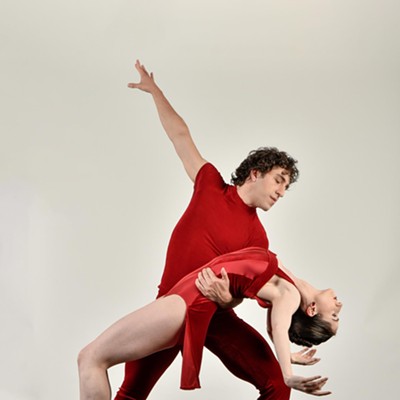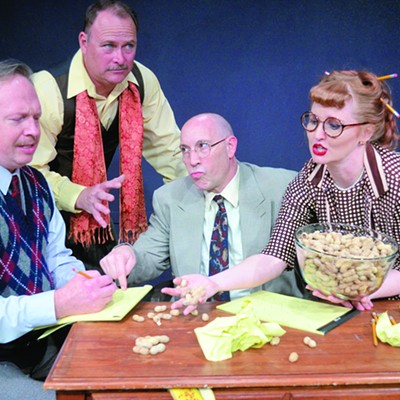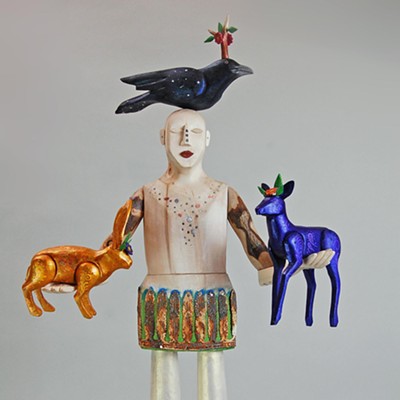Administrations on Trial
Wanted For War Crimes--Panel Discussion7 p.m., Monday, Feb. 28
UA Aerospace and Mechanical Engineering Auditorium
Northeast corner of Speedway Boulevard and Mountain Avenue
621-5665
Greg Knehans--a graduate student in the UA's Political Science Department and member of Refuse and Resist--wasn't particularly impressed when the Bush administration recently referred to a United Nations resolution while calling for Syria to pull troops out of Lebanon. "It's very much established," says Knehans, "that the U.S. completely disregards international law, charters and resolutions when it chooses to; it really shows the level of hypocrisy involved in all this."
"All this" is the history of the United States' foreign policy, which will be put on trial Monday in a panel discussion led by members of the National Lawyers Guild in Tucson, who will analyze the actions of past and present administrations in light of international law.
Knehans--an organizer of the event--notes, "Many examples found in the invasion of Iraq have involved systematic violations of human rights according to the U.N. charter, Geneva Convention, Convention on Torture ... all of which the United States is a signatory to. More specifically, the U.N. charter and other agreements proscribe the targeting and killing of civilians, which the Bush administration has done; it also outlaws the destruction of civilian infrastructure. Also, the United States--by using depleted uranium (in the shells of armor-piercing bullets)--is using an illegal weapon of mass destruction. It's highly radioactive, and counts as a nuclear weapon under international law."This isn't new," Knehans adds. "It was done in the first Gulf War, and since then, there have been consistent reports of a tremendous increase of cancer and leukemia in areas where the shells were used."
For other fascinating examples, show up for the 7 p.m. panel, which is free and open to the public.
Sweet Serotonin
The Myth Of Sleep--Dr. Rubin Naiman7:30 to 9:30 p.m., Friday, Feb. 25
St. Philip's in the Hills
4440 N. Campbell Ave.
327-3485
If you've ever been tempted to skip unburdening your soul in favor of simply falling asleep in your shrink's overstuffed chair, Dr. Rubin Naiman--assistant professor in the UA's Integrative Medicine program--doesn't knock you for it. "Given what we know about the connection between mental health and poor sleep," he's said, "many people might be better off just napping on their therapist's couch."
Naiman has spent a great deal of his life contemplating sleep, sleep problems, dreams and other aspects of our nightly lapses of consciousness. In addition to his work within the UA, he also founded the sleep health program at Canyon Ranch Health and Fitness Resort, created a software program designed to address sleep problems (The Sleep Doctor: Help for Insomnia and Other Sleep Problems) and is the author of Healing Sleep: The Science and Spirit of Sleeping, Dreaming and Awakening.
What makes Naiman--a clinical psychologist--different from others in the field is that he approaches sleeping and dreaming from both a scientific and spiritual perspective.
"Ultimately, I believe that dusk, darkness, dawn and daylight are the best sleep and waking medicines," Naiman has said. He maintains that we need to "come to terms with our fear of both literal and figurative darkness," while speaking knowledgeably about EEG lines and circadian rhythms.
Naiman's psychological approach is informed by Jungian ideas, and the Southern Arizona Friends of Jung are hosting the Friday lecture, which is $15 for members and $20 for nonmembers.
Enlightened Shopping
Southwest Indian Art Fair10 a.m. to 5 p.m., Saturday, Feb. 26; 10 a.m. to 4 p.m., Sunday, Feb. 27
Arizona State Museum
University Boulevard and Park Avenue
621-6302
The annual Southwest Indian Art Fair is, according to the ASM press release, "Southern Arizona's premier Indian art show and market." This year's event marks the 11th time the ASM has hosted the fair, helping--along the way--to educate those shoppers most likely to seek out Indian arts for purchase.
"... (H)elping the consumer to be more aware," says Tony Eriacho, vice president of the Council for Indigenous Arts and Culture, "and showing them what to be aware of is one of our goals. We also strongly support organizations, such as Arizona State Museum, who are willing to help the consumer appreciate what they are buying."
Although Eriacho will be at the event both days with handouts and displays intended to assist those interested in becoming better-informed shoppers of Indian arts, the fair itself will be fun for people of all ages, whether they're knowledge-seeking shoppers or simply hungry. Demonstrations of Hopi carving, Navajo sand painting, Navajo weaving, Tohono O'odham basket weaving and flute making will take place alongside performances by the Hopi Senom Dancers, Navajo recording artist Sharon Burch, the Dineh Tah' Navajo Dancers and many other regional musicians and dancers. And the food--buffalo burgers, roast mutton, fry bread, Indian tacos, roasted corn--will be overshadowed only by the artists themselves; more than 200 craftspeople from around the region will show and sell pottery, Hopi kachina dolls, jewelry, baskets, rugs, paintings and more.
This year's featured artist is Hopi carver Lawrence LeAllen Acadiz, a self-taught kachina doll maker. Admission is $8 for adults, $3 for kids ages 12 to 16 and free for those 11 and younger. UA students get in free with a CatCard.
Pardon the Pun
Grimm Tales--UA School Of Theatre Arts8 p.m., March 3-5; 2 p.m., March 6
Directing Studio Room 116, UA Drama Building
Southeast corner of Park Avenue and Speedway Boulevard
621-1162
The Grimm brothers, Michael Swanson explains, didn't start out as folklorists.
"They started as collectors of information about Germany," he says. "In the beginning of the 19th century, they published a number of books about German grammar, German history ... but the folk tales sold."
So the brothers who didn't start as folklorists began revising collections of stories that certainly didn't start as the fairytales we know today. And as the Grimms came to understand that parents were buying the books for their children, the brothers began to modify the stories they'd gathered in the Dark Forest and other parts of Germany.
"They cleaned up some of the stories a bit," says Swanson. "In the original 'Ashputtel' (Cinderella), for example, there's some stuff that happens that's pretty ... um, pardon the pun--grim."
Now Swanson--associate professor in the UA's School of Theatre Arts and director of the first spring workshop production, Grimm Tales--is staging a production that, according to the UA press release, "takes the Grimm tales we think we know and brings them back to their ... sources."
"When the prince comes to the house with the shoe," says Swanson, "the other sisters try to put it on, like in other versions. But in the one we're staging, the stepmother offers them a knife to cut off their toes.
"Some of the original stories," Swanson continues, "aren't just violent ... there are also some scatological images. 'The Golden Donkey' involves a donkey that produces gold--I'm trying to say this genteelly--from various bodily orifices."
Icky: 1; Genteel: 0.
Call for tickets and information.







